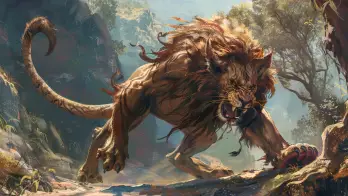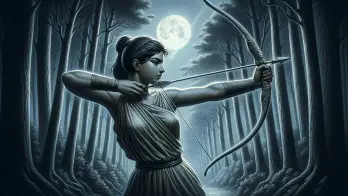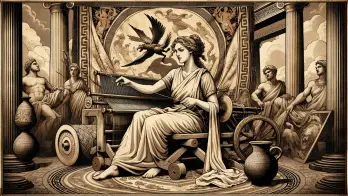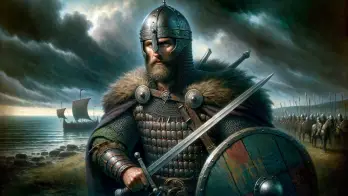As the daughter of Zeus and Leto, and the twin sister of Apollo, Artemis was among the most esteemed deities of the ancient Greeks, particularly those residing in great metropolises.
Her attributes varied by region, but she was generally regarded as the goddess of hunting and wild nature, often depicted dancing with nymphs in mountains, forests, and swamps.
Additionally, the goddess embodied the ideal athlete, safeguarding young sportspeople who participated in various games and Olympiads.
Who Was Artemis?
The Greek goddess of the hunt, wild animals, nature, childbirth, children, and purity, held an important place in ancient Greek religion and mythology. She was commonly linked with Selene, the personification of the Moon, and Hecate, another lunar deity.
She was one of Greek mythology’s most distinguished lunar deities, alongside the two goddesses mentioned above.
Accompanied by a large entourage of nymphs, mortals, and hunters, Artemis frequently roamed the forests of Greece. Her Roman equivalent was the goddess Diana.
In Greek tradition, Artemis was the daughter of Zeus and Leto and the twin sister of Apollo. Although the twins were born out of wedlock, Delos was the only place where Leto could deliver her children, as Hera, Zeus’ wife, had forbidden her from giving birth anywhere on land.
Artemis was typically born first and then assisted Leto in delivering her second child, Apollo. Like her brother, she was a child-nurturing deity and patroness of young children, particularly young girls, and women.
She was also worshipped as one of the principal goddesses of childbirth and midwifery, along with Eileithyia and Hera.
Much like Athena and Hestia, Artemis preferred to remain a virgin goddess and swore never to marry. Thus, she was one of the three Greek virgin goddesses over whom the goddess of love and lust, Aphrodite, had no influence.
In mythology and literature, the goddess was often portrayed as a hunting goddess of the woods, surrounded by her followers, who were not to be crossed.
In the story of Actaeon, the young hunter saw her bathing naked and was transformed into a deer by the angry goddess, after which he was devoured by his own hunting dogs, who did not recognize their own master.
In the tale of Callisto, the girl breaks her vow of virginity and is driven away from Artemis’ company after being impregnated by Zeus.
Artemis was one of the most widely worshipped Ancient Greek deities, with her temples, altars, shrines, and local veneration found throughout ancient Greece.
Her great temple at Ephesus was one of the Seven Wonders of the Ancient World before being burned to the ground.
Artemis’ symbols included a bow and arrow, a quiver, and hunting knives, while the deer and cypress were sacred to her. Her Roman equivalent, Diana, was especially revered on the Aventine Hill in Rome, near Lake Nemi in the Alban Hills, and in Campania.
Genealogy
According to Greek mythology, Artemis’ genealogy is as follows:
Parents
- Father: Zeus, king of the gods and god of the sky, thunder, and lightning;
- Mother: Leto, a Titan goddess of motherhood and modesty.
Siblings
- Twin brother: Apollo, god of music, prophecy, healing, and poetry;
- Half-siblings (from Zeus): Ares, Athena, Dionysus, Hebe, Hermes, Helen of Troy, Persephone, Perseus, and many others.
Lovers
- The goddess was primarily known for her virginity, and there are few myths about her romantic relationships. However, she was sometimes associated with the god of the hunt and wild places, Pan.
Children
- Artemis was not known to have any children in Greek mythology. In one myth, she turned the nymph Callisto into a bear after Callisto had been seduced by Zeus, and Callisto’s son, Arcas, was later transformed into a bear as well. However, she was not their mother.
Sacred Elements of the Goddess of the Hunt
The ancient Greeks recognized the goddess Artemis, the patroness of the hunt, through several distinct elements.
Bow
One of the most representative symbolic elements associated with the goddess of the hunt is the famous bow of Artemis. According to mythology, the Cyclopes gave her the bow at the request of Zeus, and it was a formidable weapon.
The arrows shot by the goddess were said to never miss their target and could bring death, disease, or complete curses to women and girls who did not show her the proper respect.
Golden Chariot
Although often depicted in various paintings and sculptures as a goddess of the forest who liked to run freely through the woods with her nymphs, Artemis traveled through the air in a golden chariot pulled by five golden-horned deer.
Spear
Though rare, she is sometimes depicted holding either a hunting or fishing spear. The hunting spear of Artemis can be found in Ovid’s Metamorphoses, while the fishing spear is linked to the cult of the goddess as the patroness of fishing.
Stag
Deer were considered sacred animals by the goddess Artemis. She fell in love with these wild animals when she saw a stag larger than a bull, with its antlers shining in the moonlight.
The special relationship between the goddess of the hunt and these wild animals is exemplified by the five golden-horned deer that pull the goddess’s chariot.
Hunting Dogs
According to legend, Artemis, the goddess of the hunt, was often accompanied by hunting dogs, faithful animals given as a gift from the god Pan in the Arcadian forest.
Pan gifted her two black dogs, three reddish ones, and one white one, which could even hunt lions. Additionally, Pan gave the goddess seven bitches of the best Arcadian breed.
Bear
The tradition of sacrificing a bear for the goddess Artemis originated in the Brauron cult. According to the legend recounted by the Byzantine writer Suidos in Arktos e Brauroniois, Artemis tamed a bear and presented it to the people of Athens.
They played with it until a group of girls provoked the bear, causing it to attack them. One of the girl’s brothers killed the bear in retaliation, and Artemis sent a plague in revenge.
To end the plague, the Athenians sought advice from an oracle, which suggested that no Athenian virgin should be allowed to marry until she had served Artemis in her temple, playing the role of the bear for the goddess.
Boar
The boar, a favored prey of hunters but difficult to tame, was also frequently sacrificed to Artemis as a tribute to her hunting prowess. The boar was responsible for the deaths of both Oeneus and Adonis at the hands of Artemis.
Myths and Legends
In ancient Greek and Roman mythology, Artemis (also known as Diana) was one of the principal goddesses.
She was the daughter of Zeus and Leto and the twin sister of the god Apollo. Artemis was the leader of the hunt, overseeing both male and female deities of the hunt and wild animals, particularly bears.
Additionally, Artemis was the goddess of childbirth, nature, and harvests. As the goddess of the moon, she was sometimes equated with the goddesses Selene and Hecate.
The Trojan War
In Homer’s epic poem, the Iliad, Artemis played a peripheral role in the Trojan War. She was occasionally referred to as “the protective goddess of archers,” “the noisy huntress goddess,” or “the wild goddess, the mistress of wild creatures.”
The goddess supported the Trojans and even healed Aeneas after he was wounded by Diomedes.
One notable incident at the beginning of the Trojan War involved Artemis rescuing Iphigenia, the daughter of Agamemnon.
According to legend, King Agamemnon angered the goddess by killing a deer considered sacred during a hunt.
As punishment, Artemis ordered the sea winds to stop, preventing the fleet of the Achaeans from moving any further.
In a desperate attempt to save his army, Agamemnon offered his daughter, Iphigenia, as a sacrifice to appease the goddess.
However, upon seeing the agony of the young girl, Artemis replaced Iphigenia with a doe on the sacrificial altar and made her a priestess in her sanctuary in Tauris.
Zeus’ Gifts
The god Apollo was considered the shining light of the day, while Artemis was believed to be the pale light of the night. After her birth, she approached her father, Zeus, embraced his sacred knees, and made a request:
Father, grant your daughter the gift of remaining a virgin. Like Apollo, I ask for a bow and quiver of arrows. However, I know you won’t arm me yourself, so I ask that even the Cyclopes forge me a good quiver and fill it with arrows.
Also, please grant me the right to carry a torch and wear a tunic that won’t hinder me while hunting. I desire a retinue of sixty Oceanid nymphs and twenty nymphs to serve me when I’m not hunting deer and stags, and they will tend to my shoes and faithful dogs.
Choose one city under my protection, as I will seldom remain in it. I will mostly reside in the mountains.
Zeus listened to his daughter’s request in silence and then, smiling to himself, replied:
My child, your wishes are granted, and I fulfilled your request.
Pleased with the gifts from her father, Artemis set out through the mountains with her retinue of maidens.
Scaling the shady peaks and proud rocks, whipped by the cold winds, the goddess hunted all wild creatures from dawn until night.
Artemis relished seeing the blood and beasts struggling in the cruel agony of death. She would draw her bow powerfully, and nothing could escape her when she aimed.
Her arrow traveled swiftly like the wind from her well-strung bow, never failing to strike its target. When struck, the wild creature would stumble and stop in its tracks. It would then turn its head to the goddess and let out a soft groan, as if questioning, before succumbing to death.
Far from being moved by the wild creatures’ cruel fate, Artemis laughed with joy and raised her head to the clear sky, proclaiming:
There is no shooter in the world more skilled than the goddess of the hunt.
The Tragic Tale of Acteon
The nymphs concurred with the goddess of the hunt when she boasted about her innate abilities.
However, they also recounted the hunting prowess of a certain prince named Actaeon, who filled the woods with blood just like her. Additionally, Actaeon boasted that he was more skillful than Artemis.
The goddess became infuriated after hearing these stories, and anger filled her heart.
Upon concluding her hunt, Artemis proceeded to a lovely clearing with her retinue. The surroundings were filled with fragrant box trees and pines, and in one spot, carved into stone, was a refreshing pond from which crystal-clear water was gushing forth.
The goddess visited this spot daily to bathe in the cold water, refreshing her body with grace after a satisfying day of hunting.
One of the nymphs handed her a spear, a bow, and a quiver full of arrows.
Another assisted her in undressing while two others quickly removed her dusty shoes. Another gathered her wind-tousled hair and tied it up so it wouldn’t get wet.
The maidens used five bronze urns filled with water from the spring to cool the goddess.
Every time Artemis visited, she inquired about Actaeon and the nymphs told her that he was a skilled hunter, surpassed by no one in his abilities. The young man was proud, with a handsome face, tall and slender.
One day, Actaeon went hunting accompanied by some loyal servants. While wandering through the mountains, the procession reached the spots where the goddess Artemis usually hunted.
Some legends say that Actaeon accidentally stumbled upon these mountains, while others believe that the goddess herself enticed the young man there.
The young hunter suddenly felt an unnatural fatigue. He instructed his attendants to turn back, and he stayed behind to rest under the shade of a tall tree. The procession obeyed his orders, taking their weapons and prey, and returned to the palace.
The young hunter, alone in the forest, only with his hounds, looked around bewildered. He felt tired, and an unnatural fear pierced him like an arrow.
Since a shining brook was visible nearby, Actaeon eagerly drank from the enchanted water. Immediately, as if bewitched, he and all his hounds were drawn by an unseen thread and slowly set off along the valley.
He walked for a while and found himself in the presence of the goddess and the nymphs. Here, Actaeon halted.
Before his eyes was the most stunning image he could imagine: the naked goddess Artemis was bathing. From the bronze urns, water flowed in thin, clear streams.
However, when it touched the goddess’s body, the drops of water immediately sparkled like thousands of diamonds, flames that illuminated the entire forest.
Upon seeing the prince hidden in a bush, the nymphs shouted at him to turn away and flee as far as possible. An ancient law of Cronos stated that mortals who gazed upon the gods without consent would pay a bitter price.
Actaeon ignored the nymphs’ words and remained bewitched, his eyes fixed on the goddess. Artemis, turning and seeing the young man, yelled at him:
Unworthy! You, who have boasted that you are more skilled than me, deserve to be shot in the heart with an arrow. But you will pay dearly.
With two handfuls of water drawn from the bronze urns, she drenched the king’s son’s eyes, and Actaeon immediately transformed into a stag.
Fear overtook him, and he scampered away, followed by his once-faithful hunting dogs, who no longer recognized their master. Though he attempted to communicate with his loyal companions, all that escaped his mouth was a low, fearful roar.
Actaeon, now a stag, ran frantically through his usual hunting grounds, evading arrows, spears, stones, and even his own hunting knife thrust toward his heart.
Soon, he found himself surrounded by his own hunting hounds, and they fell upon him, biting and bringing him down. The dogs barked triumphantly, calling their master to behold their prize.
Artemis, always wandering the mountains, had no time for love or marriage to any man. Even her nymph companions dared not stray from her command lest they suffer her merciless wrath, delivered with a swift arrow from her bow.
The Giant Orion
The story goes that another renowned hunter, Orion, the son of King Hyrieus, also crossed paths with Artemis.
This giant man, so tall that his forehead touched the clouds and his chest remained above water when he bathed in the deepest sea, was devoted only to one pursuit – hunting.
Orion had a magical dog, Sirius, and together they journeyed across the seas and lands on their hunting quests.
It is said that Poseidon, the god of the sea, granted Orion the ability to walk upon water, as a token of gratitude for the hospitality shown to him by King Hyrieus.
Orion performed many valorous deeds and was celebrated for his bravery, including aiding the king of Chios in vanquishing pirates who had invaded the beautiful Greek island.
In exchange for his aid, Orion requested the king’s daughter’s hand in marriage, but the cunning king refused and drugged Orion, then removed his eyes with a concealed knife.
Orion, in agony, wished to seek revenge upon his treacherous foe, but blinded and stumbling, he fell onto the shore, his head lost amidst the waves.
Yet, he persisted and listened carefully for sounds around him, eventually discerning the distinct ring of Hephaestus’s hammers on his anvil on the island of Lemnos.
Guided by the sound, Orion journeyed to the island and beseeched the mercy of the lame god. Hephaestus heeded his plea and aided him in seeking a cure.
Orion followed the guidance of the Oracle, who instructed him to sit each morning with a child on his shoulders, facing east towards the rising sun. Due to his height, the first rays of the sun fell upon his face, and after some time, he was cured of his blindness.
Gradually, Orion’s affliction abated. His vision returned, initially feeble and indistinct, then progressively stronger until fully restored.
As he looked eastward, awaiting his complete recovery, he caught sight of the enchanting goddess Eos, and she became smitten with the courageous Orion.
The goddess of dawn was so enamored with the mortal that she bewitched him and, in a flash, transported him to the heavens.
When the other goddesses beheld the comely Orion, he captivated them. Above all, the goddess Artemis cherished him dearly, to the extent that her jealousy of Eos threatened to lead her to act rashly.
Rumors began to circulate among the Olympian deities that Artemis intended to abduct the mortal and take him as her husband. This rumor soon reached the ears of Zeus and Hera.
Artemis’s brother, Apollo, offered to shield her from her imprudent love for a mere mortal. The very next morning, at daybreak, Apollo summoned Orion.
He instructed him to promptly hunt many birds that flew in flocks above the sea of Poseidon and hunt beasts on a distant shore.
Apollo’s orders had to be executed without delay.
Orion gathered his club, bow, quiver, and spear. He donned a lion’s pelt, which he had slain some days prior, and called for his faithful dog, Sirius. Together, they set off at once on the hunt.
As soon as the hunter was barely visible on the horizon, a tiny dot lost in the distance, Apollo called out to his sister Artemis in a disguised voice:
Sister, come hither quickly! You have often proclaimed that none can surpass you in hunting. Today, I wish to put that claim to the test. If you succeed, I will concede your superiority and even acknowledge that you are more adept than I in archery. Behold, do you see that small, pale dot about to disappear? Can you take aim at it?
Confident in her abilities, Artemis agreed instantly. Focusing intently, the goddess aimed and let fly an arrow at the moving target in the distance, barely discernible in the blue. The arrow whistled through the air and struck the mark directly.
Instantly, a loud cry was heard, and Orion fell. The sea turned red with the blood of the valiant hunter, and Eos erupted into a shrill wail of triumph, crying, “Artemis, you have slain my beloved!”
Artemis mounted a golden cloud without a word and hastened to where the hunter lay in the waves.
She tenderly embraced him, overcome with grief, imploring Zeus to lift her beloved to the stars, so that he would not vanish entirely, and she could gaze upon him every day.
Moved by such anguish, Zeus assented and raised the hunter to the heavens. This is the constellation known as Orion, according to legend.
It appears at the beginning of summer and fades as winter approaches when rains fall on the sea. These downpours are perhaps tears, as recounted in poetry, and tears shed by goddesses.
So that he would not be alone in the sky, Artemis beseeched Zeus to provide him with a companion, his faithful hunting dog. Thus, one can also see Sirius, a brilliant star, clearly visible in the summer sky, in the constellation of the Great Dog, beside Orion.
Cult of Artemis, Goddess of Hunting
The cult of Artemis likely flourished in Crete during pre-Hellenic times. Nonetheless, many local cults of Artemis retained traces of other deities, often with Greek names.
Upon adoption, the Greeks identified the goddess with their own nature divinities. For instance, the virgin sister of Apollo is quite distinct from Artemis, the goddess with many breasts from Ephesus.
The dances of young girls symbolizing the dances of the forest nymphs (dryads) played a significant role in religious practices devoted to the goddess of hunting, particularly in the Peloponnesian peninsula.
Artemis was also referred to as Lymnaea or Limnatis (“Lady of the Lake”), venerated as the goddess of waters and luxuriant vegetation.
In most depictions of Artemis in paintings and sculptures, she was imagined either with a stag or her faithful hunting dog.
However, exceptions existed, such as the Tauropolia festival at Halae Araphenides in Attica, dedicated to the goddess Artemis Tauropolos (the Bull Goddess).
Each year, warriors from all over Greece gathered to participate in a peculiar ritual where each man had to be sacrificed with a sword and pour a few drops of blood in honor of the bull goddess.
Ancient Greeks were familiar with numerous myths and legends about the amorous adventures of the nymphs of the goddess Artemis.
However, according to some opinions, the original legends referred to the goddess herself rather than her nymphs.
But how was the image of the chaste goddess reconciled with the tales of Artemis’ amorous escapades that circulated in Ancient Greece?
As with the Bible, which has been modified and edited over several centuries to correspond to a particular narrative, the same occurred with the goddess Artemis.
The Greek poet Homer was the first to “alter” the goddess’s image, presenting her as an ever-virgin maiden, and other poets followed suit.
However, one trait of the goddess remained unchanged: her proverbial wrath.
Artemis has always been depicted as a vengeful deity symbolizing the hostility of wild nature toward mankind. Nevertheless, this character trait was not emphasized in Greek art.
The old sculptures and paintings depict Artemis as having a relatively mild spirit, often accompanied by one of her faithful animals.
Artemis, the deity of hunting, was venerated extensively throughout Ancient Greece. Her most celebrated cults included those on the island of Delos, which was assumed to be her birthplace, in Attica at Brauron and Mounikhia (near Piraeus), and in Sparta.
In fact, the well-known Spartans made offerings to the goddess of hunting before every new military campaign.
The festivals devoted to the goddess were famous throughout the Greek peninsula, with tens of thousands participating.
Among the most prominent festivals in honor of the goddess of hunting were those at Elaphebolia, Mounikhia, Kharisteria, and Brauronia. The Artemis Orthia Festival was held annually in Sparta.
She was also worshipped as one of the primary goddesses of childbirth, alongside Eileithyia, Aphrodite, Hera, and Hecate.
As such, the goddess of hunting and childbirth was regarded by pregnant women as a formidable deity, which is entirely understandable given the risks associated with childbirth at that time.
Artemis of Brauron
A specific myth emerged in Brauron, one of the twelve towns on the island of Attica. Founded around the 8th century BC, Brauron housed one of the most prominent sanctuaries of the goddess Artemis.
At the Brauron sanctuary, dozens of Athenian adolescents came to serve the goddess for one year. The priestesses of the goddess were referred to as arktos or “bear cubs.”
According to local legend, a bear began to visit the town of Brauron regularly, and the people there fed it, so that over time, the bear became docile.
However, a mischievous little girl frequently taunted and abused the unfortunate animal.
Observing this, the goddess of hunting blew on the beast, which immediately transformed into a violent and bloodthirsty creature. The bear attacked the girl, tearing out her eyes in some versions of the story, and in others, tearing her body apart and devouring her heart.
Eventually, the girl’s brothers captured and killed the bear. Artemis became furious and, as punishment, commanded all the young priestesses who served in her sanctuary to “act like a bear.”
The Temple of Artemis in Ephesus
Artemis Ephesia, venerated as a goddess of fertility, was especially revered in Ephesus, near Ortigia, which was believed to be the birthplace of the goddess of hunting according to Greek myths.
The cult of the goddess Artemis in Ephesus was an amalgamation of elements borrowed from the East, particularly from goddesses such as Cybele and Isis. Her main symbols were the bee, the fig tree, and the deer.
The Temple of Artemis in Ephesus, which began construction in 550 BC and was completed around 450 BC, was almost twice the size of the Parthenon of Athens and was considered one of the seven wonders of the ancient world.
The temple had at least 127 columns supporting immense architrave stone blocks, each weighing around 24 tons. Legend has it that the goddess helped raise the temple, using her incredible power to move and lift the enormous stone blocks.
The temple housed a colossal statue carved from cedarwood that represented the goddess of the hunt. Unfortunately, only the foundation and a solitary stone column have been preserved to this day.
18 Interesting Facts about the Greek Goddess Artemis
1) Artemis was the daughter of Zeus and Leto and the twin sister of Apollo.
2) She was the Greek goddess of archery, dance, and truth.
3) Artemis served as a guardian to Apollo and was also the goddess of forests, hills, wild animals, childbirth, virginity, and the moon.
4) She was one of the 12 Olympian gods and was occasionally referred to as “Hekate” during the Classical period in Athens.
5) The equivalent of Artemis in Roman mythology is Diana.
6) Artemis was primarily a virgin huntress, the wildlife goddess, and the hunters’ patroness.
7) She guarded her virginity carefully and punished anyone who threatened her purity.
8) Artemis was an important goddess in the lives of women, especially when it came to marriage and young creatures.
9) She was sometimes associated with the goddess of the moon and was called “the mistress of animals” by Homer.
10) The Temple of Artemis at Ephesus became one of the Seven Wonders of the Ancient World.
11) Apollo and Artemis teamed up to kill the children of Niobe.
12) At least two festivals were celebrated in her honor: Brauronia and the festival of Artemis Orthia.
13) Artemis spent most of her time wandering the forests with her nymphs, hunting and protecting beasts.
14) She armed herself with a bow and arrows Hephaestus and the Cyclops made.
15) In art, Artemis is often escorted by a stag or hunting dog.
16) She is the keeper of chastity and a nurturer of the young.
17) Artemis was highly favored among the rural populace of Ancient Greece.
18) In Norse mythology, Artemis’ counterpart is Ullr. In Celtic mythology, the hunting god was Cernunnos. In Egyptian mythology, the god of the hunt was Horus. In Inuit mythology, the hunting god is Nujalik.
At Ancient Theory we only use trusted sources to document our articles. Such relevant sources include authentic documents, newspaper and magazine articles, established authors, or reputable websites.
- R. Bagnall - The Encyclopedia of Ancient History. Wiley Blackwell, 2012.
- M. Carabatea - Greek Mythology. Pergamos, 2007.
- Artemis. britannica.com. [Source]
- T. H. Carpenter - Art and Myth in Ancient Greece. Thames & Hudson, 1991.
- Artemis. wikipedia.org. [Source]
- Artemis - Greek Goddess of the Hunt and the Moon. greekmythology.com.







